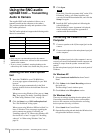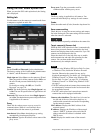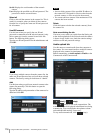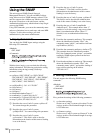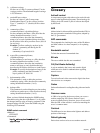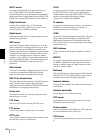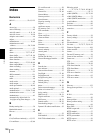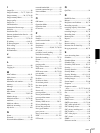
Others
Glossary
124
DHCP server
Acronym for Dynamic Host Configuration Protocol
server. The IP address of a terminal without an
individual IP address can be automatically distributed by
the Dynamic Host Configuration Protocol (DHCP). The
DHCP server assigns the IP addresses to the terminals.
Digital certificate
An electronic certificate that a CA (Certificate
Authority) attests that a public key to cancel a secret
code is issued by an authentic publisher.
Digital zoom
Zooming in/out function of an image without using an
optical zooming function.
DNS server
Acronym for Domain Name System server. As an IP
address required for connecting to the device on an IP
network is numerical and difficult to remember, the
Domain Name System was established. A domain name
is alphabetic and is easier to remember. When a client
computer uses a domain name to connect to another
computer, it asks a DNS server to translate the name into
the corresponding IP address. The client computer can
then obtain the IP address of the computer to be
connected.
EAP method
Acronym for Extensible Authentication Protocol. This
is a protocol extended from PPP (Point-to-Point
Protocol) and having an authentication function.
EAP-TLS authentication
TLS is an authentication protocol of the EAP methods
using Transport Layer Security. By using digital
certificates and other methods, EAP-TLS prevents data
falsification, eavesdropping and spoofing.
Frame rate
The number of frames of a moving image that can be
transmitted per a second.
FTP client
Software to be used for accessing the FTP server.
FTP server
A server to be used to transfer files via a network.
HTTP port
A port used to communicate between the web server and
the web client, such as a web browser.
H.264
An image compression format. The standard written by
the JVT (Joint Video Team) a joint organization for
standardization (composed of ISO and ITU-T. H.264), is
capable of transmitting video data at a higher
compression rate than that of MPEG4.
IP address
Acronym for Internet Protocol Address. An individual
IP address is basically assigned to each piece of
equipment connected to the Internet.
JPEG
Acronym for Joint Photographic Expert Group. The still
image compression technology or standards of ISO
(International Organization for Standardization) and
ITU-T. Popularly used as an image compression format
on the Internet, etc.
MAC address
A network address that uniquely identifies each LAN
card.
MPEG4
Acronym for Moving Picture Experts Group4. One of
the MPEG standards for image compression format
aiming to transmit images at a high compression rate
with lower picture quality.
Multicast
The class D IP address assigned between 224.0.0.0 and
239.255.255.255. Using this IP address enables you to
transmit the same data to multiple equipment.
Network address
The portion that identifies the local network (subnet) in
an IP address.
Network bandwidth
Bit rate that can be used for networking.
NTP server
Network time server that transmits and receives time
information over the networks.
Passive mode
The mode whereby a client FTP allows TCP connection
for data transmission to the FTP server.
POP server
A server for storing incoming e-mail until you have read
it.




